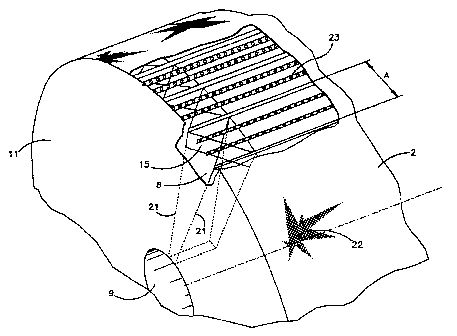Une partie des informations de ce site Web a été fournie par des sources externes. Le gouvernement du Canada n'assume aucune responsabilité concernant la précision, l'actualité ou la fiabilité des informations fournies par les sources externes. Les utilisateurs qui désirent employer cette information devraient consulter directement la source des informations. Le contenu fourni par les sources externes n'est pas assujetti aux exigences sur les langues officielles, la protection des renseignements personnels et l'accessibilité.
L'apparition de différences dans le texte et l'image des Revendications et de l'Abrégé dépend du moment auquel le document est publié. Les textes des Revendications et de l'Abrégé sont affichés :
| (12) Brevet: | (11) CA 2172257 |
|---|---|
| (54) Titre français: | MACHINE A LAVER SOUS VIDE A MEMBRURES CROISEES |
| (54) Titre anglais: | CROSS BRACED VACUUM WASHER |
| Statut: | Durée expirée - au-delà du délai suivant l'octroi |
| (51) Classification internationale des brevets (CIB): |
|
|---|---|
| (72) Inventeurs : |
|
| (73) Titulaires : |
|
| (71) Demandeurs : |
|
| (74) Agent: | NORTON ROSE FULBRIGHT CANADA LLP/S.E.N.C.R.L., S.R.L. |
| (74) Co-agent: | |
| (45) Délivré: | 2001-09-18 |
| (86) Date de dépôt PCT: | 1995-07-31 |
| (87) Mise à la disponibilité du public: | 1996-02-15 |
| Requête d'examen: | 1997-09-18 |
| Licence disponible: | S.O. |
| Cédé au domaine public: | S.O. |
| (25) Langue des documents déposés: | Anglais |
| Traité de coopération en matière de brevets (PCT): | Oui |
|---|---|
| (86) Numéro de la demande PCT: | PCT/US1995/009615 |
| (87) Numéro de publication internationale PCT: | WO 1996004061 |
| (85) Entrée nationale: | 1996-03-20 |
| (30) Données de priorité de la demande: | ||||||
|---|---|---|---|---|---|---|
|
Machine à laver à tambour dont le tambour (2) comporte un systèmes de membrures transversales (15) spécial qui empêche les torsions, qui réduit la formation de tourbillons dans les orifices radiaux d'entrée de flux (6) ménagés entre la cloison extérieure (11) et deux nervures radiales contiguës (21) et qui sert de plus de support au couvercle (23) reliant deux cloisons intermédiaires (11) peu distantes.
A washer drum is provided having a rotating cylinder (2) with unique cross bracing (15) which prevents twisting, reduces vortex
formation in radial inflow ports (6) formed between the outer head (11) and two adjacent radial ribs (21), and further provides support for
the decking (23) between closely spaced intermediate heads (11).
Note : Les revendications sont présentées dans la langue officielle dans laquelle elles ont été soumises.
Note : Les descriptions sont présentées dans la langue officielle dans laquelle elles ont été soumises.

2024-08-01 : Dans le cadre de la transition vers les Brevets de nouvelle génération (BNG), la base de données sur les brevets canadiens (BDBC) contient désormais un Historique d'événement plus détaillé, qui reproduit le Journal des événements de notre nouvelle solution interne.
Veuillez noter que les événements débutant par « Inactive : » se réfèrent à des événements qui ne sont plus utilisés dans notre nouvelle solution interne.
Pour une meilleure compréhension de l'état de la demande ou brevet qui figure sur cette page, la rubrique Mise en garde , et les descriptions de Brevet , Historique d'événement , Taxes périodiques et Historique des paiements devraient être consultées.
| Description | Date |
|---|---|
| Inactive : Périmé (brevet - nouvelle loi) | 2015-07-31 |
| Lettre envoyée | 2014-12-29 |
| Lettre envoyée | 2009-06-19 |
| Lettre envoyée | 2003-10-10 |
| Lettre envoyée | 2003-10-10 |
| Accordé par délivrance | 2001-09-18 |
| Inactive : Page couverture publiée | 2001-09-17 |
| Préoctroi | 2001-06-07 |
| Inactive : Taxe finale reçue | 2001-06-07 |
| Un avis d'acceptation est envoyé | 2001-01-09 |
| Lettre envoyée | 2001-01-09 |
| Un avis d'acceptation est envoyé | 2001-01-09 |
| Inactive : Approuvée aux fins d'acceptation (AFA) | 2000-12-04 |
| Inactive : CIB en 1re position | 2000-11-10 |
| Lettre envoyée | 2000-10-23 |
| Modification reçue - modification volontaire | 2000-10-03 |
| Exigences de rétablissement - réputé conforme pour tous les motifs d'abandon | 2000-10-03 |
| Réputée abandonnée - omission de répondre à un avis sur les taxes pour le maintien en état | 2000-07-31 |
| Inactive : Dem. traitée sur TS dès date d'ent. journal | 1998-04-23 |
| Inactive : Acc. réc. RE - Pas de dem. doc. d'antériorité | 1998-04-23 |
| Inactive : Renseign. sur l'état - Complets dès date d'ent. journ. | 1998-04-23 |
| Lettre envoyée | 1998-03-10 |
| Lettre envoyée | 1997-10-03 |
| Exigences de rétablissement - réputé conforme pour tous les motifs d'abandon | 1997-09-25 |
| Exigences pour une requête d'examen - jugée conforme | 1997-09-18 |
| Toutes les exigences pour l'examen - jugée conforme | 1997-09-18 |
| Réputée abandonnée - omission de répondre à un avis sur les taxes pour le maintien en état | 1997-07-31 |
| Demande publiée (accessible au public) | 1996-02-15 |
| Date d'abandonnement | Raison | Date de rétablissement |
|---|---|---|
| 2000-07-31 | ||
| 1997-07-31 |
Le dernier paiement a été reçu le 2001-06-21
Avis : Si le paiement en totalité n'a pas été reçu au plus tard à la date indiquée, une taxe supplémentaire peut être imposée, soit une des taxes suivantes :
Veuillez vous référer à la page web des taxes sur les brevets de l'OPIC pour voir tous les montants actuels des taxes.
Les titulaires actuels et antérieures au dossier sont affichés en ordre alphabétique.
| Titulaires actuels au dossier |
|---|
| INGERSOLL-RAND COMPANY |
| GL&V CANADA INC. |
| Titulaires antérieures au dossier |
|---|
| FREDERICK S. LEWIS |